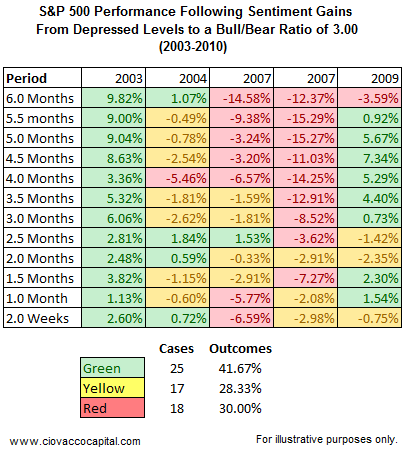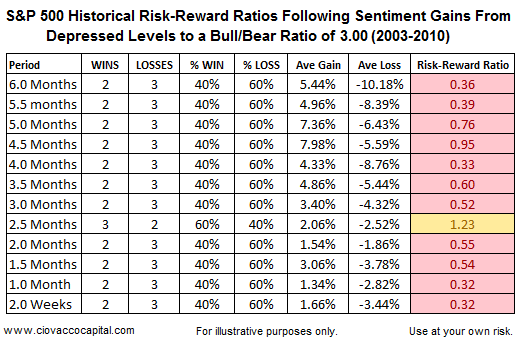Bullish Sentiment Could Dampen Stock Rally
Stock-Markets / Stock Markets 2011 Jan 14, 2011 - 10:45 AM GMTBy: Chris_Ciovacco
 After the close on December 20 with the S&P 500 standing at 1,247, we performed an analysis which led to the conclusion bullish stock market sentiment was not a barrier to further stock gains. Since then, the S&P 500 has gained 3.12% and the Investors Intelligence Advisory Sentiment Bull/Bear Ratio has increased from 2.77 to 3.00. With valuations and market technicals currently stretched, it is a good time to revisit the possible role of sentiment in the weeks ahead.
After the close on December 20 with the S&P 500 standing at 1,247, we performed an analysis which led to the conclusion bullish stock market sentiment was not a barrier to further stock gains. Since then, the S&P 500 has gained 3.12% and the Investors Intelligence Advisory Sentiment Bull/Bear Ratio has increased from 2.77 to 3.00. With valuations and market technicals currently stretched, it is a good time to revisit the possible role of sentiment in the weeks ahead.
Stock market sentiment relative to a bullish or bearish outlook can be used as a contrary indicator for stock prices when it reaches extremes. We, like many familiar with the power of sentiment, have been concerned in recent weeks as the percentage of bulls increased relative to the percentage of bears.
The December 20 analysis used a chart supplied by Robert W. Colby (www.robertwcolby.com), author of The Encyclopedia of Technical Market Analysis. In this updated analysis, we added the green lines and blue arrows to Mr. Colby’s chart, which show periods where sentiment rose from depressed levels (blue arrows) to elevated levels similar to what we have today (top portion of green lines). The Bull/Bear ratio currently stands at 3.00 (see green arrow upper right). The Dow Jones Industrial Average is shown at the bottom, below the blue arrows.

Unlike the December 20 results, the stock market’s performance following the four similar periods between 2002 and 2011 is a mixed bag. We took Mr. Colby’s chart (above) and calculated the market’s historical risk-reward profile for the cases highlighted with blue arrows and green lines from 2003, 2004, 2007 (two cases), and 2009.
The table below shows the S&P 500’s performance between two weeks and six months after sentiment rose from very depressed levels to a bull/bear ratio of 3.00. Roughly 42% of the outcomes for stocks were favorable; approximately 28% were unfavorable (but not enough to warrant selling), and about 30% of the cases resulted in S&P 500 losses of 3% or more.

As investors, what should concern us is how the market behaved after similar circumstances in the past. We need to examine the magnitude and frequency of the bullish outcomes relative to the magnitude and frequency of the bearish outcomes to better understand the risk-reward profile of the current market as it relates to sentiment. The table below tells us the outlook, based on sentiment, for the next six months is unfavorable from a risk-reward perspective.

In the cases studied, the two occurrences in 2007 are probably the least similar to the present day in terms of other factors, such as interest rate and market cycles. The cases in 2003 and 2009 are also not that similar to the present day since they occurred in the first year of new bull markets. The 2004 case, while far from a good match, aligns best with current circumstances. In 2004 after the Investors Intelligence Advisory Sentiment Bull/Bear Ratio hit 3.00, stocks basically tread water for three months, then experienced a decent pullback. From a risk-reward perspective, stocks were barely higher six months later.
Used in isolation, sentiment can be a difficult timing tool, especially on the bullish end of the spectrum. As outlined on January 6, areas for a possible intermediate-term reversal include S&P 500 levels of 1,280, 1,283, 1,291, 1,298, 1,314, and 1,326. In a recent projection of the current market technicals, we guesstimated two time windows where stocks could run into some headwinds; 01/21/10 - 02/02/10, and 02/03/10 - 02/11/10.
By Chris Ciovacco
Ciovacco Capital Management
Copyright (C) 2011 Ciovacco Capital Management, LLC All Rights Reserved.
Chris Ciovacco is the Chief Investment Officer for Ciovacco Capital Management, LLC. More on the web at www.ciovaccocapital.com
Ciovacco Capital Management, LLC is an independent money management firm based in Atlanta, Georgia. As a registered investment advisor, CCM helps individual investors, large & small; achieve improved investment results via independent research and globally diversified investment portfolios. Since we are a fee-based firm, our only objective is to help you protect and grow your assets. Our long-term, theme-oriented, buy-and-hold approach allows for portfolio rebalancing from time to time to adjust to new opportunities or changing market conditions. When looking at money managers in Atlanta, take a hard look at CCM.
All material presented herein is believed to be reliable but we cannot attest to its accuracy. Investment recommendations may change and readers are urged to check with their investment counselors and tax advisors before making any investment decisions. Opinions expressed in these reports may change without prior notice. This memorandum is based on information available to the public. No representation is made that it is accurate or complete. This memorandum is not an offer to buy or sell or a solicitation of an offer to buy or sell the securities mentioned. The investments discussed or recommended in this report may be unsuitable for investors depending on their specific investment objectives and financial position. Past performance is not necessarily a guide to future performance. The price or value of the investments to which this report relates, either directly or indirectly, may fall or rise against the interest of investors. All prices and yields contained in this report are subject to change without notice. This information is based on hypothetical assumptions and is intended for illustrative purposes only. THERE ARE NO WARRANTIES, EXPRESSED OR IMPLIED, AS TO ACCURACY, COMPLETENESS, OR RESULTS OBTAINED FROM ANY INFORMATION CONTAINED IN THIS ARTICLE. PAST PERFORMANCE DOES NOT GUARANTEE FUTURE RESULTS.
Chris Ciovacco Archive |
© 2005-2022 http://www.MarketOracle.co.uk - The Market Oracle is a FREE Daily Financial Markets Analysis & Forecasting online publication.



